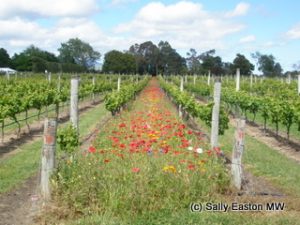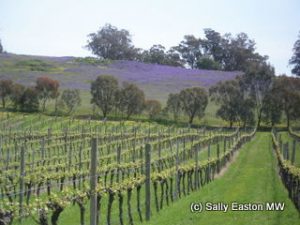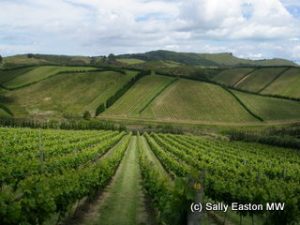Sustainability on the move

Mid row vegetation in New Zealand
A shorter version of this article was first published in Drinks Business magazine, January 2012.
The necessary mantra that sustainability is a journey not a destination is becoming manifest. And to prove that enterprises are taking continuous steps of improvement along this journey requires measurement, reporting, traceability and improvement action plans, often accompanied by independent certification.
In wine, the new world leads the field, and while some schemes are fresh out of the blocks, others have been around the blocks a few times, toning themselves up each time, getting more producers involved and getting them better involved.
Measuring the starting baseline of where producers are at is arguably the hugest undertaking. The Chilean wine industry took three years’ work building up to the January 2011 launch of their certified, voluntary code. Elena Carretero, Santa Rita’s vice president of corporate affairs and sustainability, and director of Wines of Chile’s sustainability programme said “we went through the whole process of wine making: in the vineyard, the winery, the supply chain. We put a minimum score to pass the certification process.” But, she emphasised, only after a baseline has been measured can improvements subsequently be targeted, so it is early days for the Chilean code. It’s been a slow start, said Carretero “and we have 35 to 40 [producers] in the process, and we hope to have the first 10-12 certified by the end of 2011.”
It is a small, but significant, first step, especially for a country considered a ‘viticultural paradise’, where the standard may not be as high as other countries which have more experience and measurement. Nonetheless, said Carretero said “we want to start from the beginning, and to be comprehensive for all our wineries. We need to start from a level that is not so high. Then we can get higher.”
Balancing the carrot against the stick is tricky, even in a country such as South Africa, which has a long and normalised history of measurement and recording, even before the country introduced its certified Integrated Production of Wine (IPW) programme in 1998.

Will SA’s lead in wine sustainability become as memorable as this?
The Cape’s voluntary scheme is well adopted, with several evolutions: South Africa leads the industry in biodiversity conservation, with more hectares conserved for biodiversity than are under vine. Given that the Cape Floral Kingdom, a biodiversity hotspot, accounts for 0.5% of the African continent’s area and 20% of its flora, this is an important achievement, via the Biodiversity and Wine Initiative (BWI) scheme, which has existed since 2004. In 2006, BWI guidelines were added into IPW as an extra voluntary step.
More recently, said Su Birch, CEO of Wines of South Africa, is the addition “in 2011 of a carbon footprint calculator. The wineries, via IPW, are being encouraged to calculate their current usage as a base and to compare their progress year on year. IPW will collect all the inputs and work out an industry norm relative to size and area so wineries can evaluate themselves against peers and against best practice.”
In the previous year, the sustainability seal was introduced, and as part of this, said Daniël Schietekat, IPW manager “we’ve developed an electronic database and link with SAWIS [industry data collection, dissemination; administrates Wine of Origin scheme] to speed up and improve traceability.” The benefits of this are clear as the IPW scheme implements new government policies and legislation, including “the new pesticide management policy, the national climate change and the national waste management strategies.”
As well as incorporating additional elements of sustainability, it’s getting tougher to achieve IPW certification. From 2012, the pass mark will be 65%, having been 60% in 2010, 55% in 2009, and 50% in 2008. And producers wanting to include BWI in their IPW certification must achieve 70%.
To use the sustainability seal every link in the production chain – farm, cellar, bottler – must register and comply with IPW guidelines, so 100% of fruit in any wine, even if bought and blended from many different growers, must be IPW-accredited to use the sustainability seal. Use of the sustainability seal is running at around 85%.

Australia’s Strathbogie Ranges looking pretty
By comparison, the figure for Australia’s more recent scheme, Entwine Australia (environment and wine), currently requires 85%.
The Aussies have been uncharacteristically bashful about their sustainability work. Entwine, explained Jonathan Green, natural resources manager at the Winemakers’ Federation of Australia, is “an accreditation program for sustainable vineyards and wineries. When both are members the winery is permitted to market wine as sustainably produced.“ It’s voluntary, and members must also provide an annual report on resource use optimisation, waste handling, biodiversity achievements and carbon emissions. Continuous improvement is a mandated part of certification, “each year you need to demonstrate a new efficiency” he added.
The system was launched in 2009, evolving out of the 2004 national sustainability good practice guidelines and checklists into an annual survey and accreditation programme. Green said “we’re at the data collection phase at the moment – how much water, energy, fuel etc., and how that varies between operation and wine region.” Once regional baselines are understood, he said they’ll “be better placed to set performance goals for the year”, saying, without a trace of irony, “if we’d set a water reduction target last vintage we’d definitely have met it that year”, though this may not be helpful every year in true sustainability terms. “It’s easier to set a quantitative goal” for carbon emissions, he said “which will be significant given that “we are about to see a carbon tax move into law in Australia.”
Among other things, a review of the standard during 2011 resulted in a new criterion requiring growers, where they use them, to consider using chemicals less hazardous to beneficial organisms, and those with a lower environmental impact. Soil protection measures have broadened to include improved organic matter and fertility. And “by the end of 2011” Green said “we’ll provide members with a performance report, for example on your property you created this amount of carbon emission. The average in your region was x”, to encourage improvement. But he added “Australian regions are very different, with different environmental challenges. In setting an Australia sustainability standard, it needs to be very flexible.”
In the meantime, membership so far accounts for less than 20% of Australia vineyards and 40% of production. Green said “some are undertaking the certification process and finding it a walk in park, saying we’ve being doing it for 20 years. Others are finding it difficult, which means we’re getting it about right.” And at the moment it’s a watching brief “and we’ll review the certification standard again early in 2012 to ensure it incorporates best available scientific knowledge on sustainability practices.”

New Zealand’s green and pleasant land
It is neighbouring New Zealand, which since 1997, has been on the sustainability journey the longest of any wine-producing nation, with Sustainable Wine Growing New Zealand (SWNZ). Philip Manson, science and innovations manager for New Zealand Winegrowers said “changes have been incremental, and the thing that’s changed the most is people’s engagement, their understanding of the importance of sustainability [despite] some who are still dragging the chain.”
A quite revolutionary impetus came in 2007, with a policy change by Winegrowers. Manson said “in the early 2000s our involvement sat at 50-55% of the vineyard area, right through the period of vineyard expansion, so our engagement wasn’t growing proportionately. In 2007 the Winegrowers board decided that by 2012 New Zealand would be ‘100% sustainable’.” They stated that to take part in industry activities, including Winegrowers’ international marketing events, by 2010 producers had to be accredited by an independently audited environmental programme, such as SWNZ, ISO14001 or organic/biodynamic.
With “that orange-coloured, carrot-shaped stick, our membership took off” said Manson. Effectively growers “can’t sell grapes without being accredited to a programme, it’s become a condition of supply. It’s created some tension, but it’s been a major step forward.” Between 2007 and 2011, membership by vineyard acreage more than doubled to reach 95% of the total vineyard area, in a time frame when the vineyard area increased by over 130%. Membership by winery number increased fourfold, reaching 95% of production.
Another step change came a year later when the annual scorecards moved to a fully electronic system, and it moved to a ‘good agricultural practice’ approach, with scorecards weighted to ‘major must-dos’, ‘minors’ and ‘recommended’. Members must achieve 100% of the majors, and 80% of the minors.
Reporting both biodiversity enhancement and water use were made ‘must-dos’ in 2009, though, said Manson “we have a lot of water in New Zealand compared with other wine producing areas, but availability is starting to become more of an issue, in terms of what happens to water quality downstream.” And while limits are set with pesticides, including having achieved the elimination of organophosphates over time, water measurements are more about getting users to understand their usage relative to the regional average, with the aim of using water more efficiently. Indeed, said Manson “one winery’s use was so high, that they subsequently found a water leak.”
In 2012, measuring and reporting energy use will also fall into the ‘must-do’ category.
With their more robust electronic database, Manson said the next step is greater data management, with the intention to invest in some rigorous analysis now that they have two and sometimes three years worth of data on some measurements. Manson said to expect much more noise from New Zealand in the next six to twelve months.
Engagement rather than compliance is the persistent theme for California’s Sustainable Winegrowing Program (SWP). SWP has always been a self-assessment workbook. There are no minimum standards, but plenty of education and best practice toolkits for self-improvement. Allison Jordan, executive director of the California Sustainable Winegrowing Alliance explained “the idea is that you enter where you are, and the workbook provides guidance regarding how to make improvements in all areas, starting from your own baseline.”
And, she added, between 2004 (the baseline reporting) and 2009 (the latest report), “we showed improvement in 60% of the 227 criteria” in the workbook. After focused education, she said, we “increased grower performance for 35 of the 38 IPM criteria, for seven out of seven energy efficiency vineyard criteria, and seven of ten energy efficiency criteria.” This resulted in enough electricity savings to power a community of 8,500 for a year (55m kwh), and to remove 30,000 tons of CO2 emissions.
Since the programme’s launch in 2002, self assessments have been completed that cover about 70% of California’s vineyard acreage and 65% of the state’s production.
The workbook was given a major overhaul in 2006, with the addition of an air quality chapter, and expanded soil erosion criteria. It is undergoing another major review and gap analysis of every criterion to address new regulations and new resources. Jordan said “we expect to have the new workbook completed by the middle of 2012.”
A major step in January 2010 saw the introduction of optional third party certification, for which 58 criteria, and improvement of others, must be met. In its first 22 months, some 11% of California’s vineyard acreage has been certified to Certified California Sustainable Winegrowing standards. Jordan reported “the certification programme has led to significant improvements in the wineries and vineyards that are certified.” And, she added “these pre-requisite criteria will be revisited over time, and may become more stringent, or include more pre-requisites over time.”
Next on the agenda for the California wine industry, said Jordan is the recent commencement of “a full life cycle analysis that includes electricity, fossil fuel use, and packaging and distribution.”
As the three goalposts of environmental, economic and social equity sustainability necessarily keep moving, such evolving overarching sustainability programmes are gradually incorporating some of the ‘single-issue’ initiatives, such as LCA GHG emissions, organic/biodynamic, carbon neutral and water footprints. Increasingly robust data will ensure the trek can be tracked transparently.



